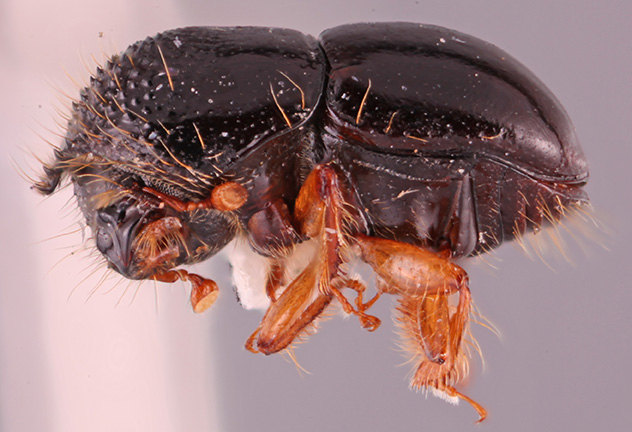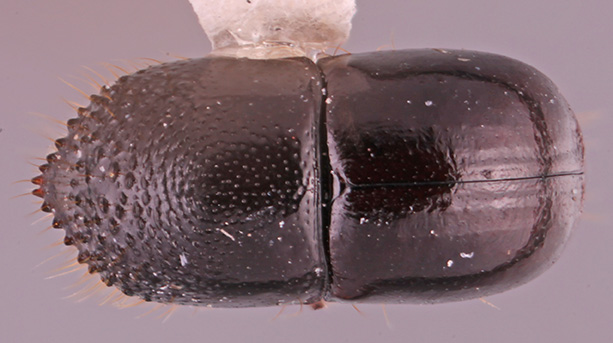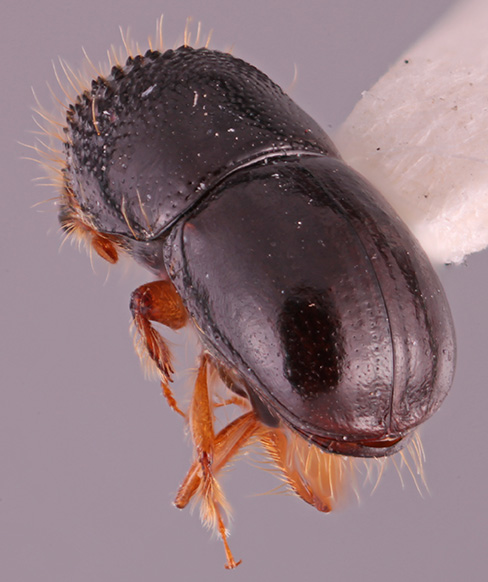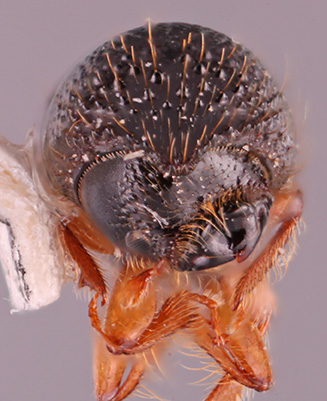Cnestus nitidipennis
|
Cnestus nitidipennis lateral; S.M. Smith |
|
Cnestus nitidipennis dorsal; S.M. Smith |
|
Cnestus nitidipennis declivity; S.M. Smith |
|
Cnestus nitidipennis frontal; S.M. Smith |
Taxonomic history
Xyleborus nitidipennis Schedl, 1951a: 88.
Cnestus nitidipennis (Schedl): Kalshoven, 1959b: 165.
Diagnosis
2.8−3.2 mm long (mean = 3.0 mm; n = 4); 2.14–2.28 times as long as wide. This species can be distinguished by the uniquely emarginateemarginate:
notched at the margin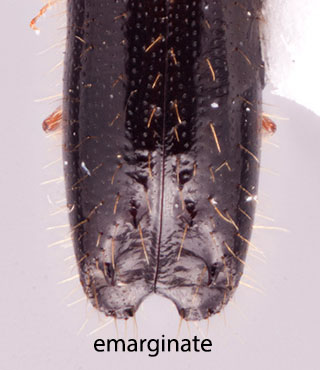 epistomal margin; enlarged mandibles (in laterallateral:
epistomal margin; enlarged mandibles (in laterallateral:
pertaining to the side
 view protruding forward at 90° to the plane of the fronsfrons:
view protruding forward at 90° to the plane of the fronsfrons:
region of the head from just above the epistoma to a point that is just dorsal to the inner apices of the eyes
, dorsoventrally deeper than normal; in anterioranterior:
the front or forward; opposite of posterior view, with an upwardly directed, smooth, rounded process on the dorsaldorsal:
view, with an upwardly directed, smooth, rounded process on the dorsaldorsal:
of or relating to the upper surface; opposite of ventral
 side); absence of a mesonotal mycangial tuftmycangial tuft:
side); absence of a mesonotal mycangial tuftmycangial tuft:
tuft of setae that denotes the mycangia exterior opening
 on the pronotalpronotal:
on the pronotalpronotal:
pertaining to the pronotum
basebase:
point or edge closest to the body; opposite of apex ; pronotumpronotum:
; pronotumpronotum:
the dorsal surface of the thorax
from dorsaldorsal:
of or relating to the upper surface; opposite of ventral
 view type 6; pronotumpronotum:
view type 6; pronotumpronotum:
the dorsal surface of the thorax
apexapex:
point or edge furthest from the body; opposite of base
 strongly producedproduced:
strongly producedproduced:
referring to a part of the exoskeleton that is extended, lengthened or elevated
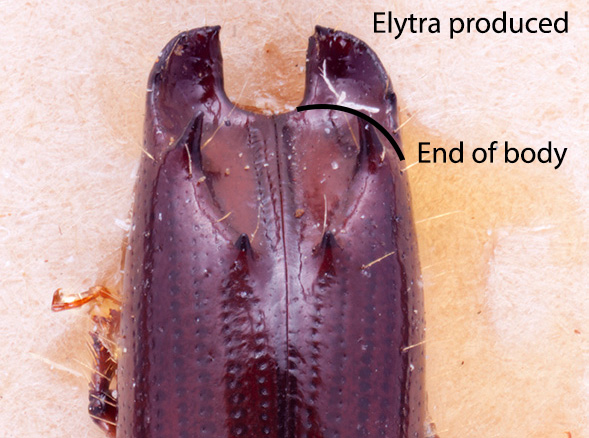 , extending to a process with numerous serrations; body glabrousglabrous:
, extending to a process with numerous serrations; body glabrousglabrous:
smooth, devoid of vestiture
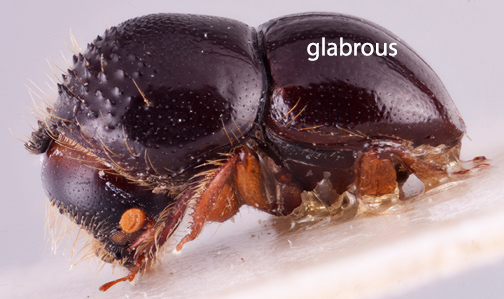 , strongly shiningshining:
, strongly shiningshining:
appearing glossy or bright in luster; referring to a surface that is polished and reflects light well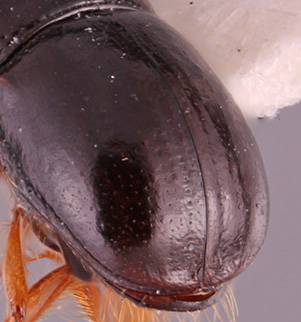 ; elytralelytral:
; elytralelytral:
pertaining to the elytra
declivitydeclivity:
downward slope of either the pronotum or elytra
 strongly rounded; protibiaprotibia:
strongly rounded; protibiaprotibia:
tibia of the first pair of legs
very slender with three large, narrow denticlesdenticle:
a small tooth, the sides of which are equal and the tip is above the middle of the base on outer margin; antennalantennal:
on outer margin; antennalantennal:
pertaining to the antennae
club type 1, with no sutures visible on the posteriorposterior:
toward the rear end; opposite of anterior
 face; and three segmented antennalantennal:
face; and three segmented antennalantennal:
pertaining to the antennae
funicle.
This species is very similar to C. protensus and can be distinguished by the smaller size, pronotalpronotal:
pertaining to the pronotum
basebase:
point or edge closest to the body; opposite of apex with punctures clearly finer, sparser, surface smooth, shiningshining:
with punctures clearly finer, sparser, surface smooth, shiningshining:
appearing glossy or bright in luster; referring to a surface that is polished and reflects light well , pronotumpronotum:
, pronotumpronotum:
the dorsal surface of the thorax
appearing narrow, sides of pronotumpronotum:
the dorsal surface of the thorax
parallel for approximately 2/3 total length.
May be confused with
Distribution
China (Fujian, Hainan, Sichuan, Yunnan), India (Arunachal Pradesh, Sikkim), Indonesia (Java), Taiwan, Thailand, Vietnam
Host plants
likely polyphagous; recorded from Eupatorium (Asteraceae) (Kalshoven 1959bKalshoven 1959b:
Kalshoven LGE. 1959b. Studies on the biology of Indonesian Scolytoidea 4. Data on the habits of Scolytidae. Second part. Tijdschrift voor Entomologie 102: 135-173 + pls. 15-22.) and Carpinus (Betulaceae) (Smith et al. 2020bSmith et al. 2020b:
Smith SM, Beaver RA, and Cognato AI. 2020b. A monograph of the Xyleborini (Coleoptera, Curculionidae, Scolytinae) of the Indochinese Peninsula (except Malaysia) and China. ZooKeys 983: 1-442. https://doi.org/10.3897/zookeys.983.52630)
Remarks
Both C. nitidipennis and C. protensus possess unique morphology among Cnestus species, including the pronotalpronotal:
pertaining to the pronotum
apexapex:
point or edge furthest from the body; opposite of base
 very strongly producedproduced:
very strongly producedproduced:
referring to a part of the exoskeleton that is extended, lengthened or elevated
 , very slender protibiaprotibia:
, very slender protibiaprotibia:
tibia of the first pair of legs
, enlarged mandibles, and absence of a mycangial tuftmycangial tuft:
tuft of setae that denotes the mycangia exterior opening
 . These morphological characters are convergent with Neotropical genera that are domicile parasites of other ambrosia beetles such as Sampsonius Eggers, 1935 (Xyleborini) and Amphicranus Erichson, 1836 (Corthylini) (Wood 2007Wood 2007:
. These morphological characters are convergent with Neotropical genera that are domicile parasites of other ambrosia beetles such as Sampsonius Eggers, 1935 (Xyleborini) and Amphicranus Erichson, 1836 (Corthylini) (Wood 2007Wood 2007:
Wood SL. 2007. Bark and ambrosia beetles of South America (Coleoptera: Scolytidae). Brigham Young University, M.L. Bean Life Science Museum; Provo, 900 p.). Further investigation of their behavior is necessary to determine if these species are also domicile parasites.
DNA data
Sequences available for COI and CAD.
COI: OP617768
CAD: OP607197

